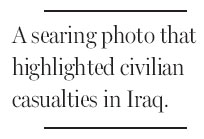Society
Face of war looks back, years later
Updated: 2011-05-15 08:00
By Tim Arango (New York Times)
|
Samar Hassan had never seen the photo of her taken after her parents were killed by American soldiers in Iraq in 2005. Chris Hondros / Getty Images |
 |
MOSUL, Iraq - Until early May, Samar Hassan had never glimpsed the photograph of her that millions had seen, never knew it had become one of the most famous images of the Iraq war.
"My brother was sick, and we were taking him to the hospital and on the way back, this happened," Samar said. "We just heard bullets.
"My mother and father were killed, just like that."
The image of Samar, then 5 years old, screaming and splattered in blood after American soldiers opened fire on her family's car in the northern town of Tal Afar in January 2005, illuminated the horror of civilian casualties and has been one of the few images from this conflict to rise to the pantheon of classic war photography. The picture has gained renewed attention as part of a large body of work by Chris Hondros, the Getty Images photographer recently killed on the front lines in Misurata, Libya.
The photograph of Samar is frozen in history, but her life moved on, across a trajectory emblematic of what so many Iraqis have endured. In a country whose health care system has almost no ability to treat the psychological aspects of trauma, thousands of Iraqis are left alone with their torment.
Now a 12-year-old, Samar lives on the outskirts of Mosul in a two-story house with four other families, mostly relatives.
Samar's older sister, Intisar, and her husband, an unemployed former police officer, care for her. Two of his sons are policemen, and their salaries support the extended family.
The pains of war have been visited on thousands of Iraqis, but even here Samar's story stands apart. Three years after her parents were killed, her brother Rakan died when an insurgent attack badly damaged the house where she lives now. Rakan had been seriously wounded in the shooting that killed their parents, and he was sent to Boston for treatment after Mr. Hondros's photos were published.
Intisar's husband, Nathir Bashir Ali, suspects his house was bombed by insurgents as retribution for sending Rakan to the United States. "When Rakan came back from America, everyone thought I was a spy," he said.
Samar left school last year because she was too shy and not doing well, Mr. Ali said, although Samar said she would like to return and hoped to be a doctor when she grew up. She leaves the house only on infrequent family excursions and has two friends who visit to play with dolls and chat.
She spends her days cleaning, listening to music and watching episodes of her favorite television show, the Turkish soap opera "Forbidden Love," about lovers named Mohanad and Samar.
"I am Samar," she said, wearing a long red dress and sitting on the couch next to Mr. Ali. Two of her siblings, also in the car when their parents were killed, sat nearby.
"I've taken them many times to the hospital, where they get pills" for emotional problems, Mr. Ali said. "When we go out and see a family, they get sad," he said. Sometimes he finds the children in a room together, crying. "When they remember the accident, it's like they just died."
The photo of Samar had far-reaching impact, for it was visual testimony to a particular scourge of this war: the shooting of innocent civilians.
The image was a point of discussion at the highest reaches of the United States Pentagon as it considered ways to reduce civilian casualties.
During a recent interview, Samar, hugging a pillow to her chest, recalled the photographer: "He was taking pictures of me, I remember. Then he stopped, and they brought me a jacket and put me in the truck and treated the wound on my hand. And they gave me some toys."
She said she understood that the picture showed the world "the sad thing that is happening in Iraq."
She pointed to a family photograph on the wall. "I always dream about my father and mother and brother," she said.
The New York Times
E-paper

Green works
Wuxi becomes 'test case' for facing country's environmental challenges
The global rise of Chinese brands
China-EU trade on solid ground
ZTE banks on innovation
Specials

The song dynasty
There are MORE THAN 300 types of Chinese operas but two POPULAR varieties are major standouts

Cut above the rest
One of the world's oldest surgeons has performed more than 14,000 operations

From the ground up
Architect of Guangzhou Opera House has many projects under way, including 2012 Olympics.

